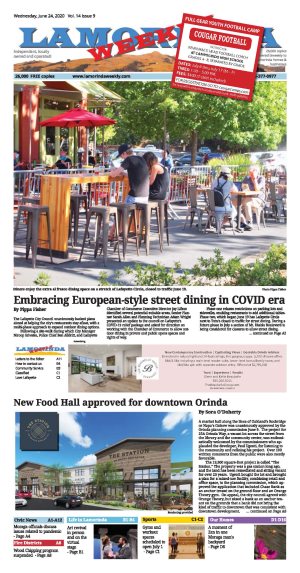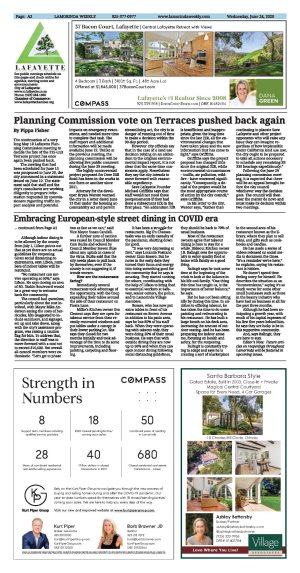| | Published June 24th, 2020
| Embracing European-style street dining in COVID era
| | | By Pippa Fisher |  | | Diners enjoy the extra al fresco dining space on a stretch of Lafayette Circle, closed to traffic June 19. Photo Pippa Fisher |
The Lafayette City Council unanimously backed plans aimed at helping the city's restaurants stay afloat, with a multi-phase approach to expand outdoor dining options.
 Following a site-walk during which City Manager Niroop Srivatsa, Police Chief Ben Alldritt, and Lafayette Chamber of Commerce Executive Director Jay Lifson identified several potential suitable areas, Senior Planner Sarah Allen and Planning Technician Adam Wright presented an update to the council on Lafayette's COVID-19 relief package and asked for direction on working with the Chamber of Commerce to allow outdoor dining in private and public opens spaces and rights of way.
Following a site-walk during which City Manager Niroop Srivatsa, Police Chief Ben Alldritt, and Lafayette Chamber of Commerce Executive Director Jay Lifson identified several potential suitable areas, Senior Planner Sarah Allen and Planning Technician Adam Wright presented an update to the council on Lafayette's COVID-19 relief package and asked for direction on working with the Chamber of Commerce to allow outdoor dining in private and public opens spaces and rights of way.
 Phase one relaxes restrictions on parking lots and sidewalks, enabling restaurants to add additional tables. Phase two, which began June 19 has Lafayette Circle next to Tutu's closed to traffic for street dining. During a future phase in July a section of Mt. Diablo Boulevard is being considered for closures to allow street dining.
Phase one relaxes restrictions on parking lots and sidewalks, enabling restaurants to add additional tables. Phase two, which began June 19 has Lafayette Circle next to Tutu's closed to traffic for street dining. During a future phase in July a section of Mt. Diablo Boulevard is being considered for closures to allow street dining.
 Although indoor dining is to be allowed by the county from July 1, Lifson points out that as yet there are no actual guidelines for reopening. Given social distancing requirements, says Lifson, numbers of indoor tables will be restricted.
Although indoor dining is to be allowed by the county from July 1, Lifson points out that as yet there are no actual guidelines for reopening. Given social distancing requirements, says Lifson, numbers of indoor tables will be restricted.
 "No restaurant can survive operating at 50%," says Lifson. He says closing an area of Mt. Diablo Boulevard would be a great way to welcome back the community.
"No restaurant can survive operating at 50%," says Lifson. He says closing an area of Mt. Diablo Boulevard would be a great way to welcome back the community.
 The council had questions, particularly about the cost involved, with Mayor Mike Anderson saying the costs of barricades, kits (suggested to include sanitizers, and signage), set up and take down, along with the city's assistance program, was raising a caution flag for him. To address that, the direction to staff was to move forward with a cost not to exceed $10,000. But overall all council members were enthusiastic. "Let's get to phase two as fast as we can," said Vice Mayor Susan Candell.
The council had questions, particularly about the cost involved, with Mayor Mike Anderson saying the costs of barricades, kits (suggested to include sanitizers, and signage), set up and take down, along with the city's assistance program, was raising a caution flag for him. To address that, the direction to staff was to move forward with a cost not to exceed $10,000. But overall all council members were enthusiastic. "Let's get to phase two as fast as we can," said Vice Mayor Susan Candell.
 A further note of caution was raised by Council Member Cam Burks and echoed by Council Member Steven Bliss about any uptick in cases of the virus. Burks said that the city needs plans to pull back by themselves, even if the county is not suggesting it, if trends worsen.
A further note of caution was raised by Council Member Cam Burks and echoed by Council Member Steven Bliss about any uptick in cases of the virus. Burks said that the city needs plans to pull back by themselves, even if the county is not suggesting it, if trends worsen.
 How are the restaurants faring?
How are the restaurants faring?
 Immediately several restaurants took advantage of the opportunity, with the Coop expanding their tables around the side of their restaurant on Fiesta Lane.
Immediately several restaurants took advantage of the opportunity, with the Coop expanding their tables around the side of their restaurant on Fiesta Lane.
 Millie's Kitchen owner Eva Clement says they are open for takeout service from their recently renovated windows and put tables under a canopy in their lower parking lot. She says they closed for two months initially and took advantage of the time to do some improvements, including painting, carpeting and flooring.
Millie's Kitchen owner Eva Clement says they are open for takeout service from their recently renovated windows and put tables under a canopy in their lower parking lot. She says they closed for two months initially and took advantage of the time to do some improvements, including painting, carpeting and flooring.
 It has been a struggle for restaurants. Big O's Cheesesteaks was an early casualty of the pandemic, shutting down for good.
It has been a struggle for restaurants. Big O's Cheesesteaks was an early casualty of the pandemic, shutting down for good.
 "It was very depressing at first," says Locanda Positano owner Enzo Rosaro. But he notes in the early days they turned their focus and energy into doing something good for the community that he says is amazing. They started cooking for others, coordinating with the help of Lifson to bring food to essential workers at Safeway, senior centers, the police, and to Lamorinda Village members.
"It was very depressing at first," says Locanda Positano owner Enzo Rosaro. But he notes in the early days they turned their focus and energy into doing something good for the community that he says is amazing. They started cooking for others, coordinating with the help of Lifson to bring food to essential workers at Safeway, senior centers, the police, and to Lamorinda Village members.
 Rosaro, who has now put extra tables in front of his restaurant on Brown Avenue in addition to his patio area, says he has 80% of his staff back. When they were operating with takeout only, they were doing 20% of their usual business. He says that with outside dining they are now up to 50% and when they can open indoor dining following social distancing guidelines, they should be back to 70% of usual business.
Rosaro, who has now put extra tables in front of his restaurant on Brown Avenue in addition to his patio area, says he has 80% of his staff back. When they were operating with takeout only, they were doing 20% of their usual business. He says that with outside dining they are now up to 50% and when they can open indoor dining following social distancing guidelines, they should be back to 70% of usual business.
 Most of the restaurant owners agree that takeout dining is here to stay for a while. Hideout Kitchen owner J.B. Balingit sees the opportunity to enjoy quality food at home with family as a good thing.
Most of the restaurant owners agree that takeout dining is here to stay for a while. Hideout Kitchen owner J.B. Balingit sees the opportunity to enjoy quality food at home with family as a good thing.
 Balingit says he took some time at the beginning of the crisis to look at the balance in his life and family. "One thing this time has taught us, is the importance of better balance," he says.
Balingit says he took some time at the beginning of the crisis to look at the balance in his life and family. "One thing this time has taught us, is the importance of better balance," he says.
 But he has not been sitting idly by during this time. In addition to offering takeout, he has taken the time to do some painting and redecorating in his restaurant. He has built a large bench on his deck area, increasing the amount of outdoor seating. And he has been preparing the indoor areas too, focusing on health and safety, for the reopening.
But he has not been sitting idly by during this time. In addition to offering takeout, he has taken the time to do some painting and redecorating in his restaurant. He has built a large bench on his deck area, increasing the amount of outdoor seating. And he has been preparing the indoor areas too, focusing on health and safety, for the reopening.
 Balingit is constantly trying to adapt and says he is creating a sort of marketplace in the second area of his restaurant known as the library, where they plan to sell wine, and gifts such as cookbooks and candles.
Balingit is constantly trying to adapt and says he is creating a sort of marketplace in the second area of his restaurant known as the library, where they plan to sell wine, and gifts such as cookbooks and candles.
 He has made a series of videos released on social media to document the times. "It's a reminder we're here," he explains, saying his restaurant is hidden.
He has made a series of videos released on social media to document the times. "It's a reminder we're here," he explains, saying his restaurant is hidden.
 He doesn't spend time feeling sorry for himself. He describes the situation as an "inconvenience," saying it's so much worse for some other small businesses such as those in the beauty industry who have had no business at all for the past three months.
He doesn't spend time feeling sorry for himself. He describes the situation as an "inconvenience," saying it's so much worse for some other small businesses such as those in the beauty industry who have had no business at all for the past three months.
 Although he had been anticipating a growth year, with much of his capital expenses of his first five years behind him, he says they are lucky to be in this supportive community.
Although he had been anticipating a growth year, with much of his capital expenses of his first five years behind him, he says they are lucky to be in this supportive community.
 And, says Balingit, they are here to stay.
And, says Balingit, they are here to stay.
 Editor's Note: Future articles on reopenings throughout Lamorinda will be featured in upcoming issues.
Editor's Note: Future articles on reopenings throughout Lamorinda will be featured in upcoming issues. |
| | | | | | | | | | | | |




